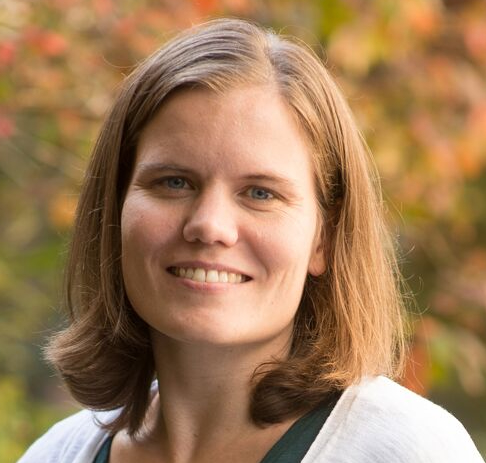“Studying supernovae is the gateway drug to physics,” said Josefin Larsson. “And SN 1987A is the Rosetta Stone of supernovae physics.”
“Massive stars end their lives in powerful supernovae explosions. Supernovae play a crucial role in the universe by creating and distributing elements that are critical for life,” she continued. “They also leave behind compact objects in the form of neutron stars and black holes, which are some of the most extreme objects known to us. They give us the opportunity to study physics in extreme conditions.”
Larsson was presenting the seventh and final STIAS Public Lecture of 2025. She is a Professor of Astrophysics at KTH Royal Institute of Technology in Sweden. She is also a member of the Swedish Royal Academy of Sciences and a Wallenberg Scholar. She obtained her MSc at Lund University, her PhD at the University of Cambridge and a postdoc at Stockholm University. Her research deals with some of the most extreme phenomena in the universe; powerful stellar explosions like supernovae and gamma-ray bursts, and the compact objects they leave behind. She investigates fundamental open questions regarding these phenomena, including how the explosions are triggered, as well as how the properties of the compact objects are connected to the properties of the progenitor stars and explosions. With her research group, Larsson addresses these questions by analysing observations that cover most of the electromagnetic spectrum.
She gave an overview of current understanding of supernovae and told the story of SN 1987A − the closest supernova in the era of modern telescopes.
She explained that supernovae are exploding stars and remain rare in our galaxy, the Milky Way, in which there is about one every 100 years. But there are many supernovae observed every day across all the galaxies. Observations go way back, such as the famous example recorded by Chinese and Japanese astronomers of the Crab Nebula in 1054.
Larsson explained that stars are giant balls of gas that shine due to fusion (initially of hydrogen into helium) in which they release energy. “Once the hydrogen runs out, they make heavier elements including carbon and oxygen, which build up in an onion-like structure. Once iron is formed, the star no longer releases energy due to fusion and starts to collapse and eject the outer layers.”
“Supernovae are therefore important because the heavier metals are made in these stars and explosions. Only hydrogen, helium and lithium were present in the very early universe.”
“Once there is iron it collapses in fractions of a second,” she added. “The outer layers are ejected at speeds of over 1000 km per second.”
A supernova explosion marks the spectacular end in the life of a massive star. They are the main sources of chemical elements that make life possible, responsible for regulating star formation in galaxies, and producers of exotic neutron stars and black holes − an object with a strong gravitational pull, from which no light escapes.
But, despite their very important role in the universe there remain unanswered questions about supernovae. “For example, we don’t know exactly how the explosions are triggered or why they collapse into different objects in the centre. There are likely different mechanisms operating in different subtypes of supernovae. There is big diversity in their properties, composition and classification,” explained Larsson.
Supernovae are detected by comparing images of galaxies and looking for changes. Obviously, this was initially done by eye. The number detected has increased over time due to better automated methods. It’s now also possible to observe them at different wavelengths beyond the capacity of the human eye to include radio, infrared, ultraviolet, X-rays and Gamma Rays.
Larsson explained that we can also study their evolution over time as the light varies. “We can take a spectrum – measuring different energy at different wavelengths. Spectra tell us about the chemical composition, temperature, density and velocity.”
And the nearby remnants provide a spatially resolved view of the explosions. “By looking at supernovae remnants, you can piece together their history. But there’s lots of diversity in the explosions, so you need large samples,” she said.
Supernova of a lifetime
Turning to Supernova 1987A, Larsson explained that it’s the brightest supernova since the Kepler Supernova (SN 1604) first observed in 1604. (SN 1604 occurred in the Milky Way, less than 20 000 light-years from the Sun and could be seen in daytime.) SN 1987A has the added advantage of the massive technological developments since then. SN 1987A was in the Large Magellanic Cloud, a dwarf satellite galaxy of the Milky Way and occurred approximately 168 000 light-years from Earth “which is actually very close – it has led to a long list of discoveries,” said Larsson.
Included in the discoveries is that Sanduleak - 69 202 is the progenitor star of SN 1987A. Studying the neutrinos released from SN 1987A has also provided much more information on the mechanisms of the explosion and the core collapse. (Neutrinos are very light particles that are abundant in the universe and born from events like exploding stars.)
SN 1987A has been observed by the Hubble Space Telescope since the early 1990s and, as current leader of the Hubble programme, Larsson showed images from the telescope dating across the three decades.
“There is lots of detailed information available from Hubble,” said Larsson. “Including details of the composition, the radioactive emissions, as well as the interaction between the ejected stellar debris and the surrounding medium.”
But the game has changed massively with observations from the James Webb Space Telescope launched in December 2021 which has substantially added to knowledge about SN 1987A – most importantly the recent discovery of the compact object.
“We didn’t see the compact object in the first 35 years of observations, but it was observed last year,” explained Larsson. “James Webb carries integral field units – each spaxel (spatial pixel) in an image contains a spectrum. This made it possible to find evidence of ionising radiation from the compact object which is most likely a neutron star.”
“3D images are also showing us what happened at the time of the explosion and giving more insight into the explosion mechanism. We can determine the geometry, velocity distribution and mixing of elements. This gives much more clarity on the full chain of events − we can watch how it evolved and understand it’s properties.”
Her work at STIAS will be to analyse new data to reveal more about the distribution of other elements from SN 1987A as well as other supernova remnants.
Larsson explained that in the era of large telescopes and Big Data there will be a dramatic increase in supernova detection. The Vera C. Rubin Observatory, formerly the Large Synoptic Survey Telescope, in the Coquimbo region of Chile began issuing it’s first images earlier this year. “It’s expected it will receive 10 million alerts every night and will detect more than 100 000 supernovae per annum, but with limited information about each.”
But why do we need to study supernovae?
In addition to being the main factory for all the chemical elements (like carbon, oxygen and iron) that make life on Earth possible and help us to understand the evolution of the universe, Larsson explained that studying supernovae results in many methodologies applicable to everyday applications and provides valuable training for data scientists. “The applications are not necessarily immediate but are a way of understanding fundamental physics better, which can lead to unexpected applications in the future.”

